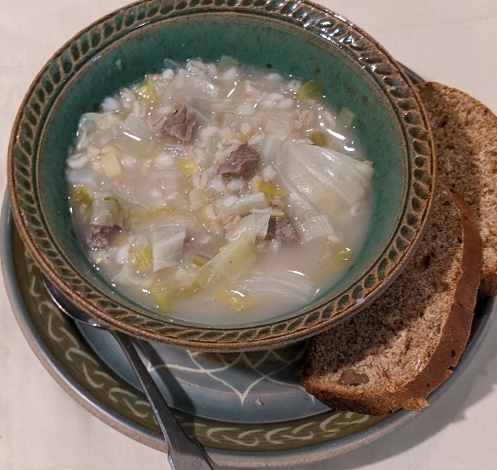Cabbage is a very ancient food going back 4,000 years. There is evidence that Mongolian nomads learned to preserve cabbage in brine bringing a new method of preservation and flavor to an already popular vegetable. It was a staple food of the builders of the Great Wall of China in 300 BC. The Celts were instrumental in bringing cabbage across Europe and may have introduced cabbage to the British Isles as early as 400 BC. For centuries this vegetable sustained many populations through famines and wars. The outcomes of battles depended on deliveries of cabbage to the armies during the 100 Years war. Cabbage was also taken on sailing ships to avoid scurvy.
Myths and legends about cabbage abound. The idea of babies coming from cabbage patches may have come from the belief that cabbage helped fertility. Women were served cabbage broth the day after their wedding. There was also a belief that cabbage could cure hangovers or even prevent them. Greeks and Romans would eat cabbage before large banquets. In Eastern European countries cabbage was seen as an antidote to vodka.
The Latin name for cabbage is Brassica from the Celtic name of Brassic. Common names for cabbage in many countries around the world come from another Celtic-Slavic word cap or kap, meaning “head.” Cabbage is truly a Scottish vegetable and can be found in traditional foods such as rumbledethumps.
Although there are many different varieties of cabbage, Shetland Cabbage/Kale is the oldest known Scottish local vegetable variety. It has been grown on The Shetland Islands since at least the 17th century. The origins of this variety are unknown. As in many cultures, the outer leaves were used as winter feed for cattle and sheep. Because of the harsh winter conditions, the seeds were planted in plantie crubs, small circular beds surrounded by stone walls. As the seedlings grew, they were transplanted into larger beds which were also surrounded with stone walls. These walls, although often in ruins, can still be found all over the islands. There has been a steep decline in Shetland Cabbage due to the growth of commercial supermarkets and other cabbage varieties.
Shetland Cabbage/Kale was immortalized in the Shetland poem “Auld Maunsie’s Cro” by Basil R. Anderson:
‘Auld Maunsie biggit him a CroTa grow him kale fir mutton broFir Maunsie never tocht him hale,Withoot sheeps shanks an kogs o’kale’
Cabbage and Barley Broth Recipe

There is a charming video on YouTube of a British couple harvesting their own cabbage and using an old recipe to make soup. I recommend watching it as it is very entertaining. This is the recipe they used. It Originated in the Islands of Scotland and is based on an authentic 19th century recipe from 1809. Scottish Barley broth can be traced back to at least the early 1600’s and many recipes can be found during the 1700’s and onwards. This recipe is from 1809 but by all accounts it hasn’t changed much in over 300 years. As with all traditional recipes, you can add or subtract from this to suit your tastes or your larder.
From Mersey Beet Gardening
Ingredients:
PEARL BARLEY – 300g (2 cups)
CABBAGE OR SPRING GREENS – Four to Six handfuls
1 LARGE LEEK trimmed, washed and chopped
A few sticks of CELERY chopped (optional)
LEAN DICED BEEF – 400g BEEF (about 1 pound)
1 STOCK CUBE (optional)
1 LARGE ONION roughly chopped
SALT & PEPPER to taste
Rinse the barley and cook in 6 cups boiling water for 30 minutes. Add the beef and cook another 40 minutes. Add remaining ingredients and simmer for about 1 hour. Salt and pepper to taste and serve with crusty bread.

